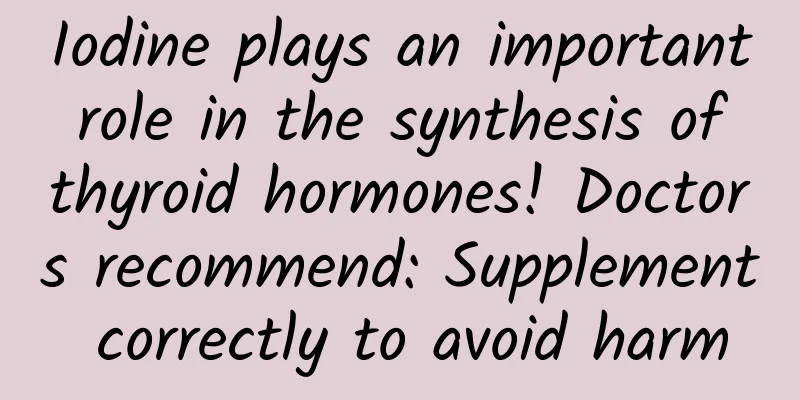Iodine plays an important role in the synthesis of thyroid hormones! Doctors recommend: Supplement correctly to avoid harm

|
Iodine is one of the essential trace elements for the body. It is mainly stored in the thyroid gland, salivary glands, breasts, gastric mucosa and other parts. It is the raw material for synthesizing thyroid hormones. However, since the human body cannot synthesize iodine, it must be obtained from the dietary environment, such as food and drinking water. May 15, 2024 is the 31st National Iodine Deficiency Disease Prevention and Control Day. Recently, 10 departments including the National Disease Control and Prevention, the National Health Commission, and the National Development and Reform Commission jointly issued the "Notice on Carrying out the 2024 Iodine Deficiency Disease Prevention and Control Day Activities", and determined the theme of the 2024 event as "Iodine-fortified salt to prevent disease, balanced nutrition for healthy living." So, what changes will happen to our bodies when we suffer from iodine deficiency? How should we eat to better obtain iodine supplements? Do you know the dangers of iodine deficiency? Iodine deficiency disease is a general term for a series of diseases caused by insufficient iodine intake in the human body due to iodine deficiency in the external environment. It is also the most widely distributed endemic disease in the world and affects the largest number of people. Iodine is an essential trace element for the synthesis of thyroid hormones. Thyroid hormones play an important role in the growth, development and metabolism of the human body. Long-term iodine deficiency will cause different harms to different people at different stages. 1. Fetal period: All the iodine needed by the fetus comes from the mother. Therefore, if the pregnant woman is iodine-deficient, the fetus will be iodine-deficient. If iodine deficiency during pregnancy lasts for a long time, it can lead to miscarriage, stillbirth, congenital malformations and increased infant mortality. 2. Neonatal period: 1 to 3 years old is a critical period for the development of the child's brain. If the child is iodine deficient for a long time during this period, it will affect the normal development of the brain, and in severe cases, it will cause cretinism, neonatal goiter, neonatal hypothyroidism, hearing impairment, intellectual impairment, etc. 3. Childhood and adolescence: Iodine deficiency during this stage will affect children's growth and development, including the increase in height, weight, and bone maturation, as well as cause thyroid enlargement, adolescent hypothyroidism, etc. How much iodine intake is normal? Iodine is an essential micronutrient for human metabolism and growth and development. Eating iodized salt is the simplest, safest and most effective way to prevent iodine deficiency. 6 g of iodized salt ≈ 120 μg of iodine, which means that consuming 6 g of salt a day can ingest 120 μg of iodine. The iodine intake recommended by the World Health Organization is: 0-5 years old, 90 μg/d; 6-12 years old, 120 μg/d; >12 years old, 150 μg/d; pregnancy and lactation, 250 μg/d. In addition to the iodine intake from salt, the rest can be obtained from food supplements. Therefore, we should eat more iodine-rich foods in our daily life. The top ten foods with high iodine content (per 100 g) are: kelp (dried) (15,878.0 μg), nori (dried) (4,323.0 μg), kelp (fresh) (923.0 μg), chicken essence (766.5 μg), clams (346.0 μg), dried shrimp (264.5 μg), shrimp paste (166.6 μg), dried shrimp (82.5 μg), cola (68.4 μg), and barbecued pork (57.4 μg). 1. Seafood: Foods rich in iodine include kelp, laver, marine fish, shrimp, and shellfish. For example, kelp soup is a delicious and nutritious dish. 2. Dairy products: Milk, goat milk and other dairy products also contain a certain amount of iodine. Drinking a glass of milk every day can not only supplement protein and calcium, but also take in some iodine. 3. Eggs: Eggs such as chicken eggs and duck eggs are also good choices. Eating a boiled egg in the morning is nutritious and convenient. Of course, we also need to pay attention to the combination of food. Don't always eat a few kinds of food alone. You should combine meat and vegetables, coarse and fine. For example, you can stir-fry kelp and lean meat together, which is both delicious and nutritionally balanced. At the same time, you should also pay attention to the diversity of food and try as many different ingredients as possible to ensure the intake of various nutrients. And our cooking methods should also be appropriate, and we should try to reduce high-temperature frying and other cooking methods, because this may cause the loss of iodine in food. We can use more methods such as steaming, boiling, and cold mixing to better retain the nutrients in food. Friends, let's take action together! Pay attention to iodine intake, develop good eating habits and lifestyles, "iodine" lights up our health path, and together we move towards a healthy and happy life! |
<<: As fruits become sweeter, are they still the “spokespersons” of health?
>>: Can patients with thyroid disease still eat iodized salt?
Recommend
What is the position of the sun and the earth at the beginning of autumn? How was the earth formed?
The Earth is the largest terrestrial planet in th...
Have you ignored these 5 abnormal signals that appear during sleep?
Recently, the well-known entrepreneur Zong Qingho...
Causes of itchy bumps at the vaginal opening
The vagina is the reproductive tract of women, th...
Conservative treatment of uterine fibroids
More and more friends are making rapid progress i...
How to cure the odor in women's lower body
How to treat the odor in women's lower body? ...
Why are cupcakes not cooked in the middle? How to fix cupcakes not cooked in the middle?
As we all know, there are many types of cakes, an...
Can I eat cherries when I have my period?
Cherry is a sweet and sour fruit. It is a warm fr...
Poor ovarian function and successful IVF
In our lives, many women may not have very good o...
Can pregnant women eat basil leaves?
Perilla leaf is a plant that can also be taken or...
What should I do if an old perineal laceration appears after a normal delivery?
Author: Lou Wenjia Peking Union Medical College H...
How do you know if your fallopian tubes are blocked?
If a woman has a blocked fallopian tube, it will ...
Dysmenorrhea starts 5 days before menstruation
A small number of female friends will start to su...
How big is the fetus at 8 weeks of pregnancy
How big is the baby at eight weeks of pregnancy? ...
Can myopia and presbyopia cancel each other out? Be careful not to see clearly at both near and far!
Myopia and presbyopia Can they offset each other?...









